Single-Grain Gate-All-Around Si Nanowire FET Using Low-Thermal-Budget Processes for Monolithic Three-Dimensional Integrated Circuits
Abstract
1. Introduction
2. Materials and Methods
3. Results and Discussion
3.1. High-Crystallinity and Controlled-Grain Si Film
3.2. Gate-All-Around Si Nanowire FET Fabrication
3.3. Highly Activated Ultra-Shallow-Junction Formed by FIR-LA
3.4. Hybrid Laser-Assisted Salicidation
3.5. Device Uniformity Characterization and FIR-LA Validation for Monolithic Three Dimension Integrated Circuits Application
4. Conclusions
Author Contributions
Funding
Conflicts of Interest
References
- Schaller, R. Moore’s law: Past, present and future. IEEE Spectr. 1997, 34, 52–59. [Google Scholar] [CrossRef]
- Mack, C. Fifty years of Moore’s law. IEEE Trans. Semicond. Manuf. 2011, 24, 202–207. [Google Scholar] [CrossRef]
- Katti, G.; Stucchi, M.; De Meyer, K.; Dehaene, W. Electrical modeling and characterization of through silicon via for three-dimensional ICs. IEEE Trans. Electron Devices 2010, 57, 256–262. [Google Scholar] [CrossRef]
- Lee, M.; Wu, S.; Yang, M.; Chen, K.; Luo, G.; Lee, L.; Kao, M. High-performance Poly-Si TFTs using ultrathin HfSiOx gate dielectric for monolithic three-dimensional integrated circuits and system on glass applications. IEEE Electron Device Lett. 2010, 31, 824–826. [Google Scholar] [CrossRef]
- Chen, H.; Chang, C.; Lu, N.; Wu, J.; Han, M.; Cheng, Y.; Wu, Y. Characteristics of gate-all-around junctionless Poly-Si TFTs with an ultrathin channel. IEEE Electron Device Lett. 2013, 34, 897–899. [Google Scholar] [CrossRef]
- Shulaker, M.; Hills, G.; Park, R.; Roger, T.; Howe, K.; Saraswat, H.; Wong, S.M. Three-dimensional integration of nanotechnologies for computing and data storage on a single chip. Nature 2017, 547, 74–78. [Google Scholar] [CrossRef]
- Levinson, J.; Shepherd, F.R.; Scanlon, P.J.; Rider, M. Conductivity behavior in polycrystalline semiconductor thin film transistors. J. Appl. Phys. 1982, 53, 1193. [Google Scholar] [CrossRef]
- Chalmers, B. High-speed growth of sheet crystals. J. Cryst. Growth 1984, 70, 3–10. [Google Scholar] [CrossRef]
- Sameshima, T. Laser crystallization for large-area electronics. Appl. Phys. A 2009, 96, 137–144. [Google Scholar] [CrossRef][Green Version]
- Chen, T.; Yeh, C.; Lou, J. Effects of grain boundaries on performance and hot-carrier reliability of excimer-laser annealed polycrystalline silicon thin film transistors. J. Appl. Phys. 2004, 95, 5788–5794. [Google Scholar] [CrossRef]
- Vandooren, A.; Franco, J. 3-D sequential stacked planar devices featuring low-temperature replacement metal gate junctionless top devices with improved reliability. IEEE Trans. Electron Devices 2018, 65, 5165–5171. [Google Scholar] [CrossRef]
- Schwarzenbach, W.; Maleville, C.; Daval, N. Advanced FD-SOI and beyond low temperature SmartCut™ enables high density 3-D SoC applications. IEEE J. Electron Devices Soc. 2019, 7, 863–868. [Google Scholar] [CrossRef]
- Ishihara, R.; Danciu, D.; Tichelaar, F.; He, M.; Hiroshima, Y.; Inoue, S.; Shimoda, T.; Metselaar, J.W.; Beenakker, C.I.M. Microstructure characterization of location-controlled Si-islands crystallized by excimer laser in the μ-Czochralski (grain filter) process. J. Cryst. Growth 2007, 299, 316–321. [Google Scholar] [CrossRef]
- Ryoichi, I.; Artyom, B.; Paul, A. Location-control of large Si grains by dual-beam excimer-laser and thick oxide portion. Jpn. J. Appl. Phys. 2000, 39, 7. [Google Scholar]
- Ryoichi, I.; Paul, C.; Barry, D.; Metselaar, C. Property of Single-Crystalline Si TFTs Fabricated with μ-Czochralski (grain filter) Process. SPIE Proc. 2003, 5004, 10–19. [Google Scholar]
- Rajendran, B.; Shenoy, R.; Witte, D.; Chokshi, N.; DeLeon, R.; Tompa, G.; Pease, R. Low thermal budget processing for sequential 3-D IC fabrication. IEEE Trans. Electron Devices 2007, 54, 707–714. [Google Scholar] [CrossRef]
- Yang, C.; Huang, W.; Hsieh, T.; Wu, T.; Wang, H.; Shen, C.; Yeh, W.; Shiu, J.; Chen, Y.; Wu, M.; et al. High gamma value 3D-Stackable HK/MG-Stacked Tri-Gate Nanowire Poly-Si FETs with embedded source/drain and back gate using low thermal budget green nanosecond laser crystallization technology. IEEE Electron Device Lett. 2016, 37, 533–536. [Google Scholar] [CrossRef]
- Deng, F.; Johnson, A.; Asbeck, P.; Lau, S. Salicidation process using NiSi and its device application. J. Appl. Phys. 1997, 81, 8047. [Google Scholar] [CrossRef]
- Colgana, E.; Gambinoa, J.; Hongb, Q. Formation and stability of silicides on polycrystalline silicon. Mater. Sci. Eng. R Rep. 1996, 16, 43–96. [Google Scholar] [CrossRef]
- Johnson, M.; Biegelsen, D.; Moyer, M. Deuterium passivation of grain-boundary dangling bonds in silicon thin films. Appl. Phys. Lett. 1982, 40, 882. [Google Scholar] [CrossRef]
- Scheller, L.; Weizman, M.; Simon, P.; Fehr, M.; Nickela, N. Hydrogen passivation of polycrystalline silicon thin films. J. Appl. Phys. 2012, 112, 63711. [Google Scholar] [CrossRef]
- Ahn, M.; Takuya Saraya, T.; Kobayashi, M.; Sawamoto, N.; Ogura, A.; Hiramoto, T. superior subthreshold characteristics of gate-all-around P-Type Junctionless Poly-Si nanowire transistor with ideal subthreshold slope. Jpn. J. Appl. Phys. 2020, 59, 7. [Google Scholar] [CrossRef]
- Mohammad, M.; Kees, B. Stacking of single-grain thin-film transistors. Jpn. J. Appl. Phys. 2009, 48, 3S2. [Google Scholar]
- IahihR, R.; Matsumura, M. Ultra-large grain growth of Si films on glassy substrate. Electron Lett. 1995, 31, 22. [Google Scholar]
- Aaron, M.; Voutsas, T.; Raj, S. A systematic study and optimization of parameters affecting grain size and surface roughness in excimer laser annealed polysilicon thin films. J. Appl. Phys. 1997, 82, 4302. [Google Scholar]
- Wu, T.; Huang, W.; Yang, C.; Chen, H.; Hsieh, T.; Lin, W.; Kao, M.; Chen, C.; Yao, J.; Jian, Y.; et al. High performance and low power monolithic Three-Dimensional Sub-50 nm Poly Si Thin film transistor (TFTs) circuits. Sci. Rep. 2017, 7, 1368. [Google Scholar] [CrossRef]
- Huang, W.; Shieh, J.; Kao, M.; Shen, C.; Huang, T.; Wang, H.; Yang, C.; Hsieh, T.; Hsieh, J.; Yu, P.; et al. Enabling N-Type Polycrystalline Ge Junctionless FinFET of Low thermal budget by in situ doping of channel and visible pulsed laser annealing. Appl. Phys. Express 2017, 10, 026502. [Google Scholar] [CrossRef]
- Huang, W.; Shieh, J.; Pan, F.; Yang, C.; Shen, C.; Wang, H.; Hsieh, T.; Wu, S.; Wu, M. Charge-trap non-volatile memories fabricated by laser-enabled low-thermal budget processes. Appl. Phys. Lett. 2015, 107, 183506. [Google Scholar] [CrossRef]
- Yang, C.; Hsieh, T.; Huang, W.; Shen, C.; Shieh, J.; Yeh, W.; Wu, M. Recent progress in low-temperature-process monolithic three dimension technology. Jpn. J. Appl. Phys. 2018, 57, 04FA06. [Google Scholar] [CrossRef]
- Ouisse, T.; Cristoloveanu, S.; Borel, G. Hot-carrier-induced degradation of the back interface in short-channel silicon-on-insulator MOSFETS. IEEE Electron Device Lett. 1991, 12, 290–292. [Google Scholar] [CrossRef]
- Ouisse, T.; Cristoloveanu, S.; Borel, G. Electron trapping in irradiated SIMOX buried oxides. IEEE Electron Device Lett. 1991, 12, 312–314. [Google Scholar] [CrossRef]
- Lawrence, T.; Vinay, V.; Greg, Y. ASAP7: A 7-nm FinFET predictive process design Kit. MicroElectron J. 2016, 53, 105–115. [Google Scholar]
- Tapas, D.; Girish, P.; Yogesh, C. Performance Evaluation of 7-nm node negative capacitance FinFET-based SRAM. IEEE Electron Device Lett. 2017, 38, 1161–1164. [Google Scholar]
- Singh, K.; Kumar, S.; Goel, E.; Singh, B.; Singh, P.; Baral, K.; Kumar, H.; Jit, S. Effects of source/drain elevation and side spacer dielectric on drivability performance of non-abrupt Ultra Shallow junction gate underlap GAA MOSFETs. Indian J. Phys. 2017, 92, 171–176. [Google Scholar] [CrossRef]
- Yang, B.; Buddharaju, K.; Teo, S.; Singh, N.; Lo, G.; Kwong, D. Vertical silicon-nanowire formation and Gate-All-around MOSFET. IEEE Electron Device Lett. 2008, 29, 791–794. [Google Scholar] [CrossRef]
- Langfeld, R.; Baumann, H.; Bethge, K.; Jex, H. CO2-Laser Induced annealing and diffusion in high energy As-ion-implanted silicon. Phys. Lett. A 1981, 82, 148–150. [Google Scholar] [CrossRef]
- James, R. Pulsed CO2 laser annealing of silicon. Semicond. Semimet 1984, 23, 555–623. [Google Scholar]
- Mia, S.; Jiaa, C.; Zhaob, Q.; Mantlb, S.; Urban, K. NiSi2/Si interface chemistry and epitaxial growth mode. Acta Mater. 2009, 57, 232–236. [Google Scholar] [CrossRef]
- Chena, H.; Linb, C.; Huang, C.; Chien, C. The effect of pulsed laser annealing on the nickel silicide formation. Microelectron. Eng. 2010, 87, 2540–2543. [Google Scholar] [CrossRef]
- Yang, C.; Shieh, J.; Hsieh, T.; Huang, W.; Wang, H.; Shen, C.; Wu, T.; Hou, Y.; Chen, Y.; Lee, Y.; et al. Enabling low power BEOL compatible monolithic 3D+ nano- electronics for IoTs using local and selective far-infrared ray laser anneal technology. In Proceedings of the 2015 IEEE International Electron Devices Meeting (IEDM), Washington, DC, USA, 7–9 December 2015; pp. 205–208. [Google Scholar]


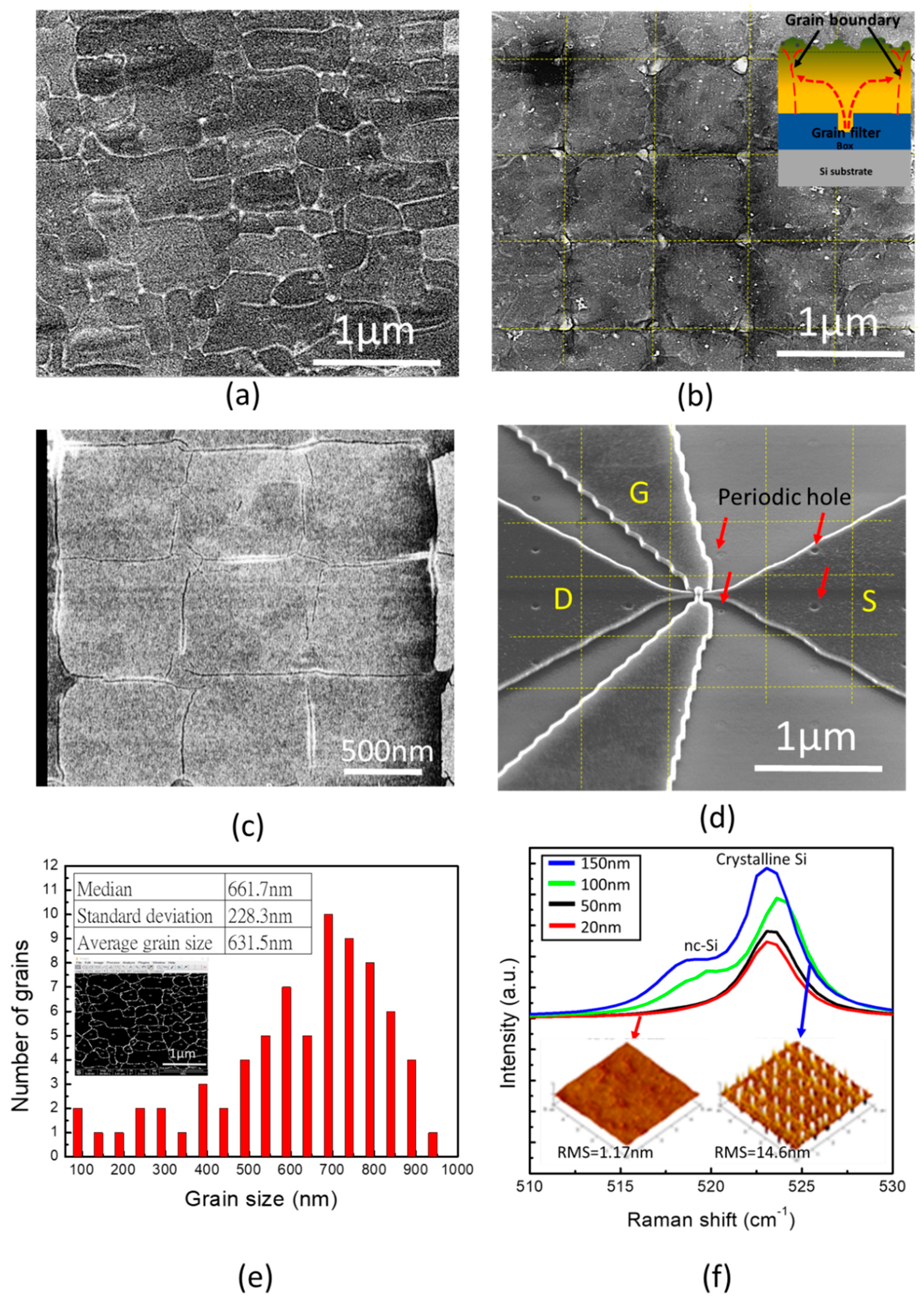
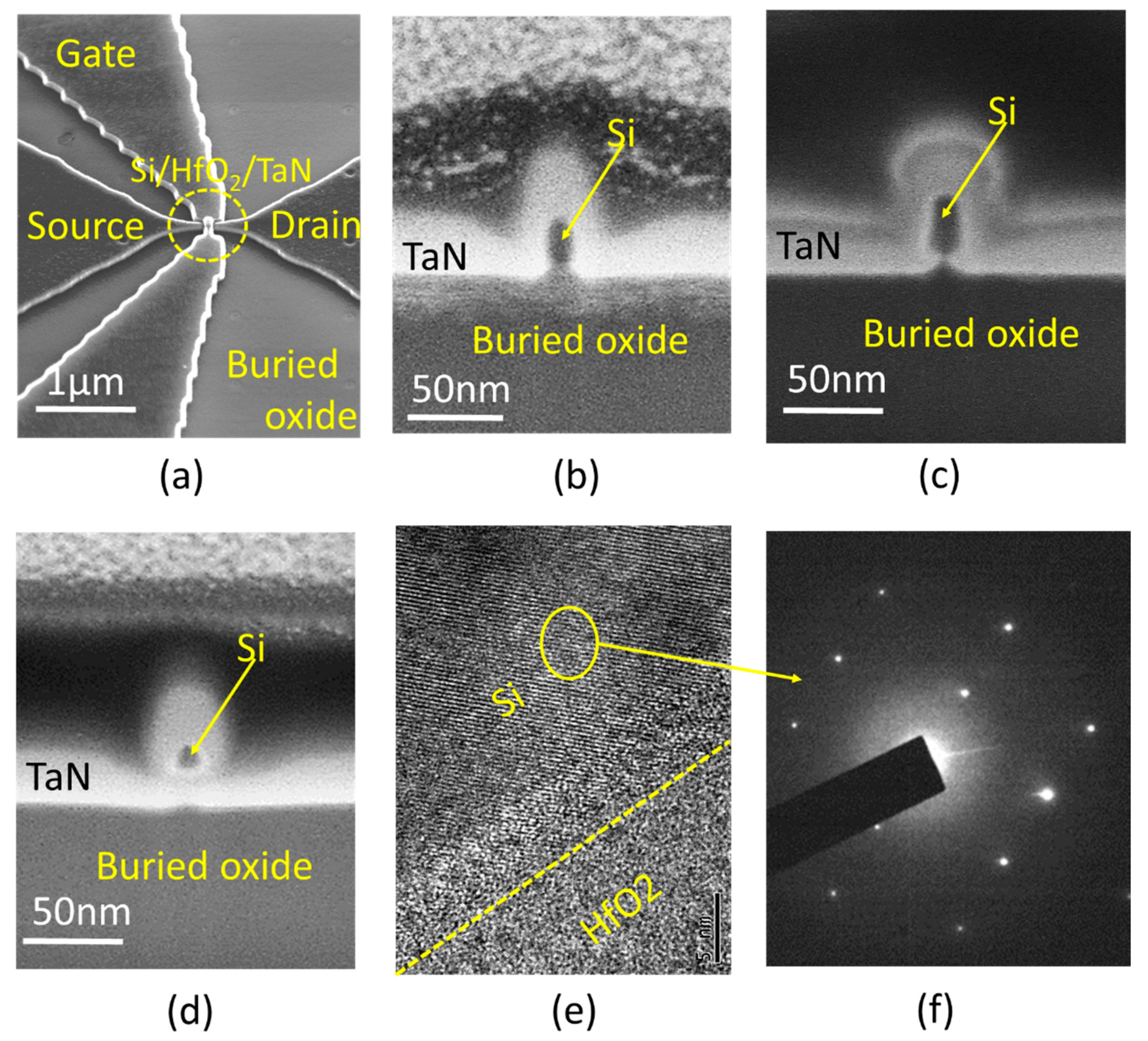
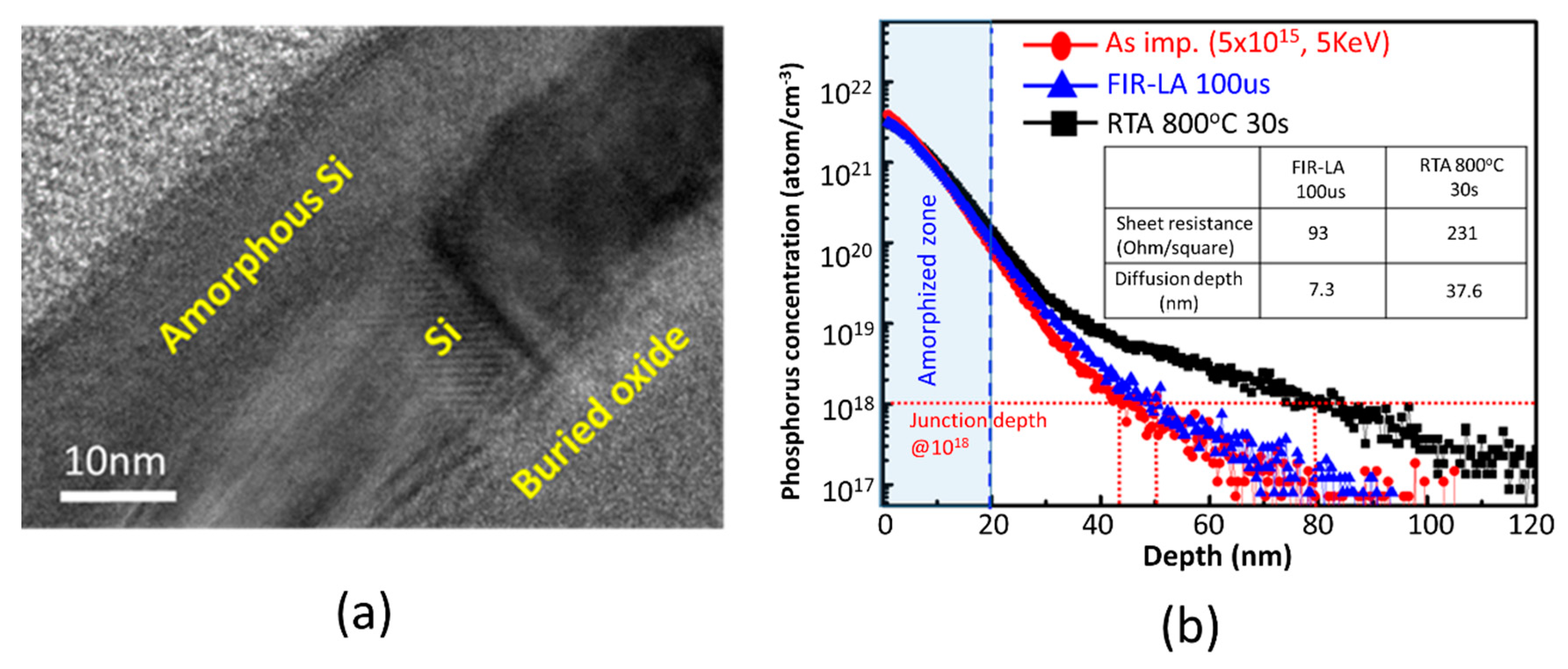
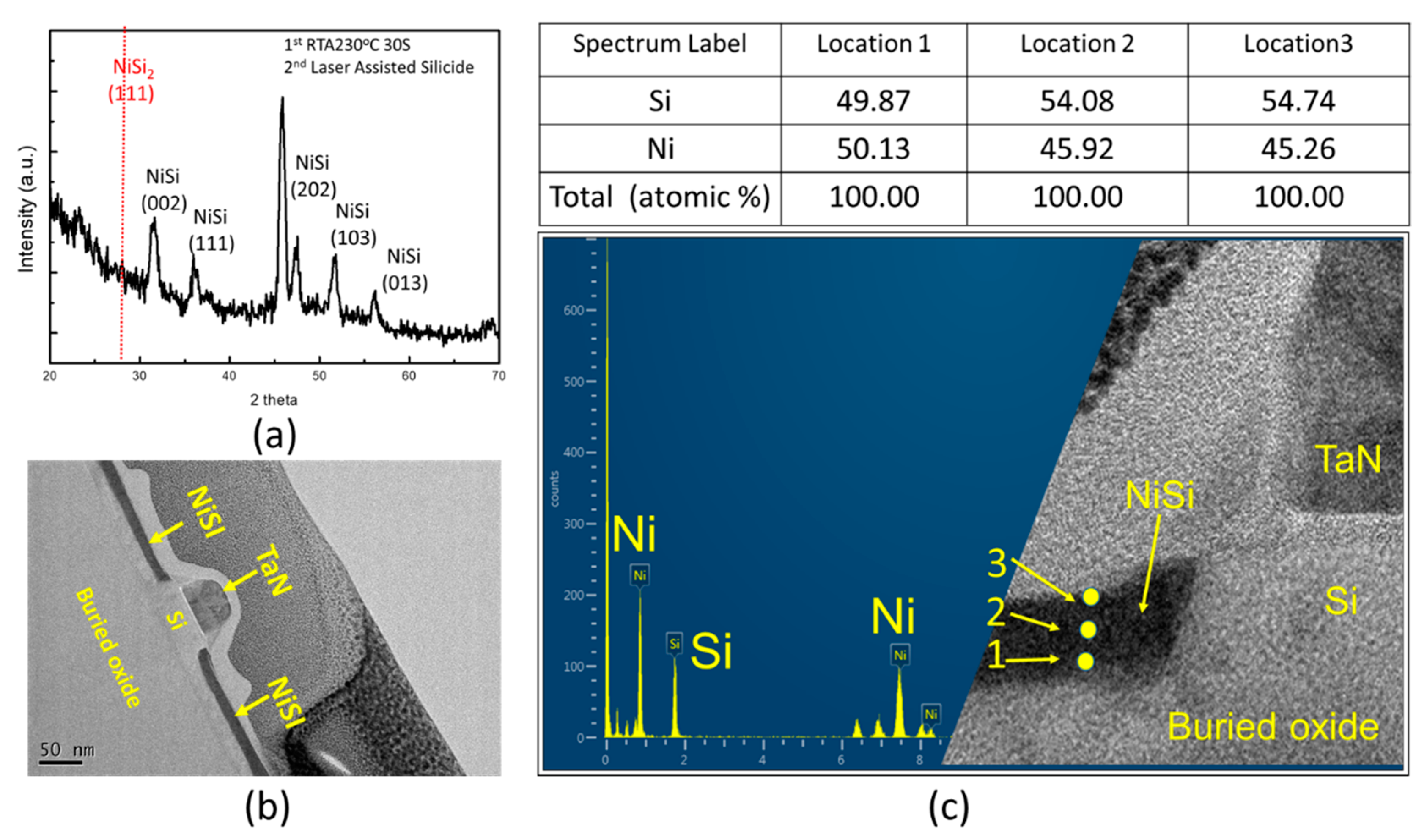
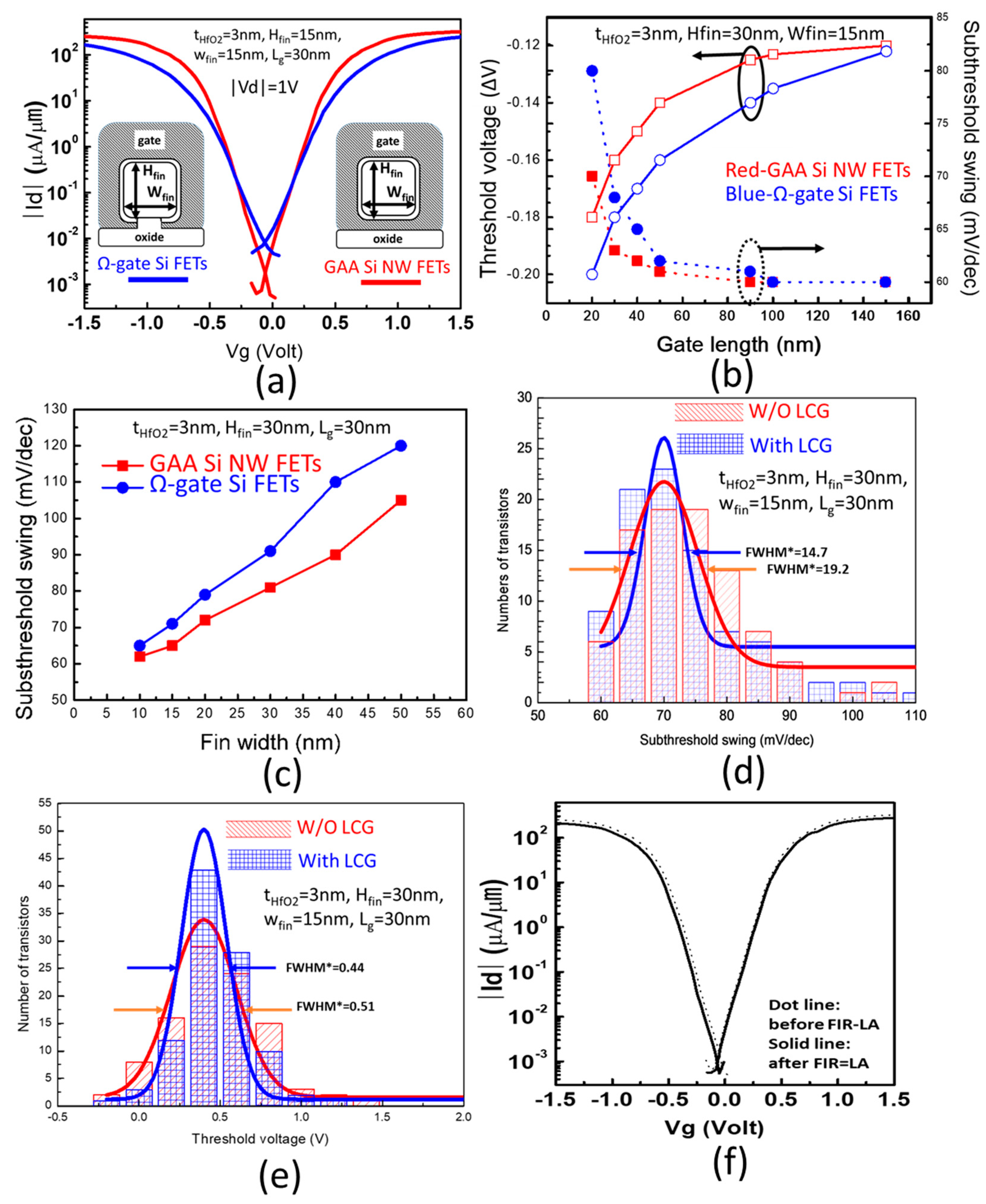
© 2020 by the authors. Licensee MDPI, Basel, Switzerland. This article is an open access article distributed under the terms and conditions of the Creative Commons Attribution (CC BY) license (http://creativecommons.org/licenses/by/4.0/).
Share and Cite
Hsieh, T.-Y.; Hsieh, P.-Y.; Yang, C.-C.; Shen, C.-H.; Shieh, J.-M.; Yeh, W.-K.; Wu, M.-C. Single-Grain Gate-All-Around Si Nanowire FET Using Low-Thermal-Budget Processes for Monolithic Three-Dimensional Integrated Circuits. Micromachines 2020, 11, 741. https://doi.org/10.3390/mi11080741
Hsieh T-Y, Hsieh P-Y, Yang C-C, Shen C-H, Shieh J-M, Yeh W-K, Wu M-C. Single-Grain Gate-All-Around Si Nanowire FET Using Low-Thermal-Budget Processes for Monolithic Three-Dimensional Integrated Circuits. Micromachines. 2020; 11(8):741. https://doi.org/10.3390/mi11080741
Chicago/Turabian StyleHsieh, Tung-Ying, Ping-Yi Hsieh, Chih-Chao Yang, Chang-Hong Shen, Jia-Min Shieh, Wen-Kuan Yeh, and Meng-Chyi Wu. 2020. "Single-Grain Gate-All-Around Si Nanowire FET Using Low-Thermal-Budget Processes for Monolithic Three-Dimensional Integrated Circuits" Micromachines 11, no. 8: 741. https://doi.org/10.3390/mi11080741
APA StyleHsieh, T.-Y., Hsieh, P.-Y., Yang, C.-C., Shen, C.-H., Shieh, J.-M., Yeh, W.-K., & Wu, M.-C. (2020). Single-Grain Gate-All-Around Si Nanowire FET Using Low-Thermal-Budget Processes for Monolithic Three-Dimensional Integrated Circuits. Micromachines, 11(8), 741. https://doi.org/10.3390/mi11080741






